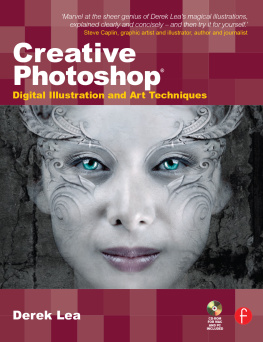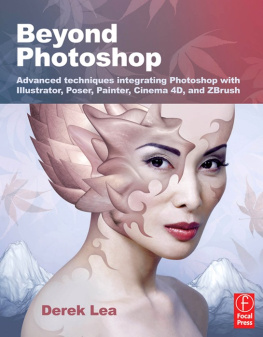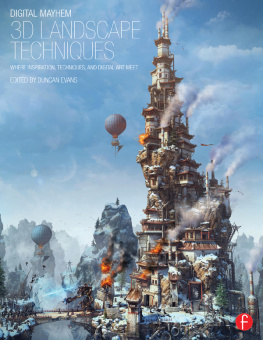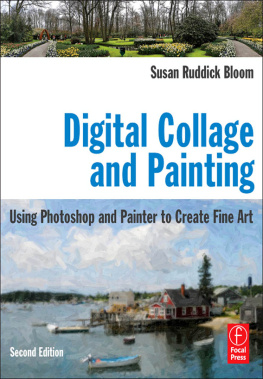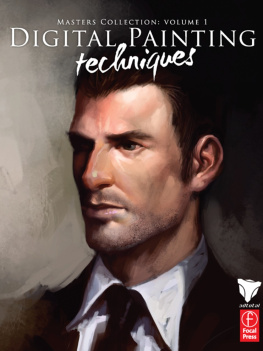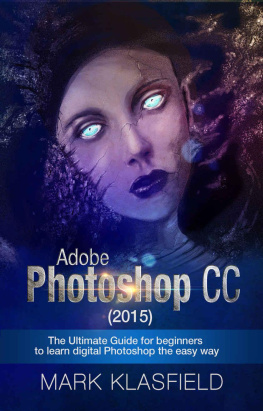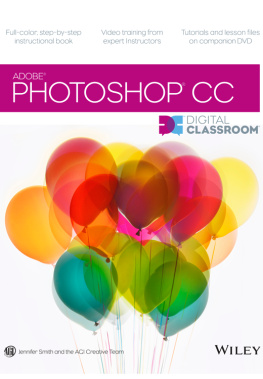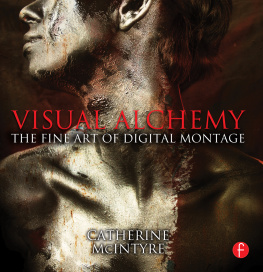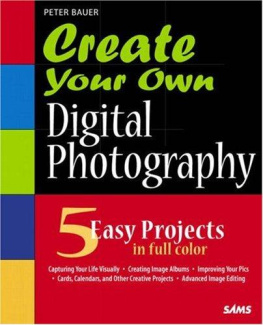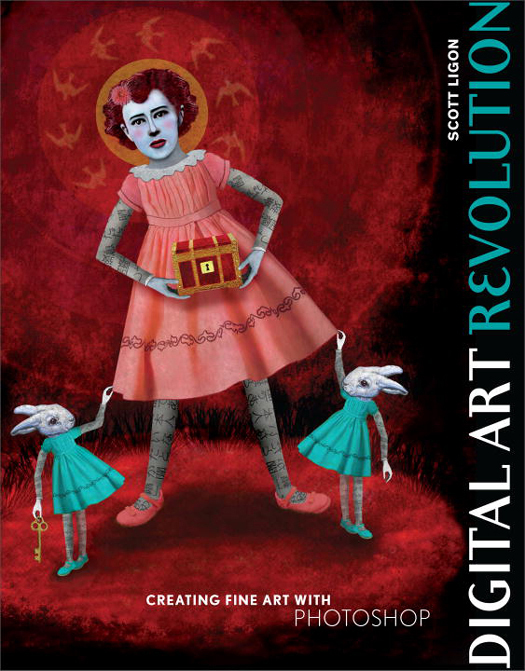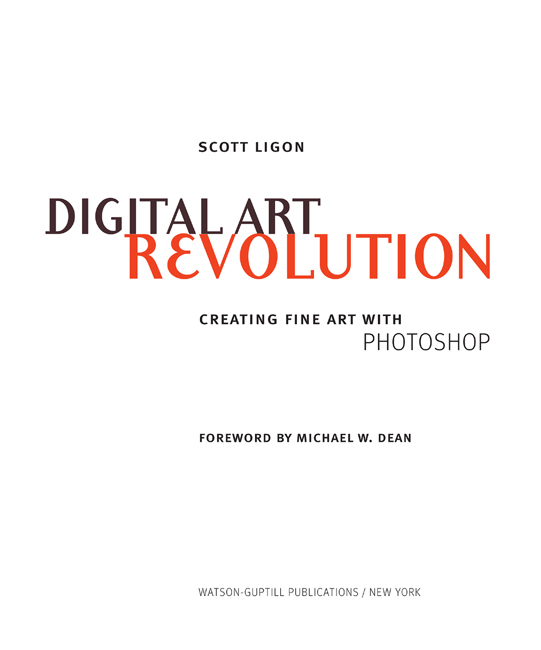Art Credits:
Front cover design: Dominika Dmytrowski
Front cover art: Visions Cindy Jerrell
Half title: Detail from Visions by Cindy Jerrell. COPYRIGHT CINDY JERRELL
Frontispiece: Dreaming of Winter by Steven Parke. COPYRIGHT STEVEN PARKE
Copyright: Katie Matusik. COPYRIGHT KATIE MATUSIK
Contents: Skateboarder by Scott Ligon. COPYRIGHT SCOTT LIGON.
Copyright 2010 by Scott Ligon
All rights reserved.
Published in the United States by Watson-Guptill an imprint of the Crown Publishing Group, a division of Random House, Inc., New York.
www.crownpublishing.com
www.watsonguptill.com
WATSON-GUPTILL is a registered trademark and the WG and Horse designs are trademarks of Random House, Inc.
Ligon, Scott.
Digital art revolution : the essential guide to creating fine art with Photoshop / Scott Ligon.
p. cm.
Includes bibliographical references and index.
eISBN: 978-0-8230-0833-9
1. Digital art--Technique. 2. Adobe Photoshop. I. Title.
N7433.8.L54 2010
776dc22
2009022670
v3.1

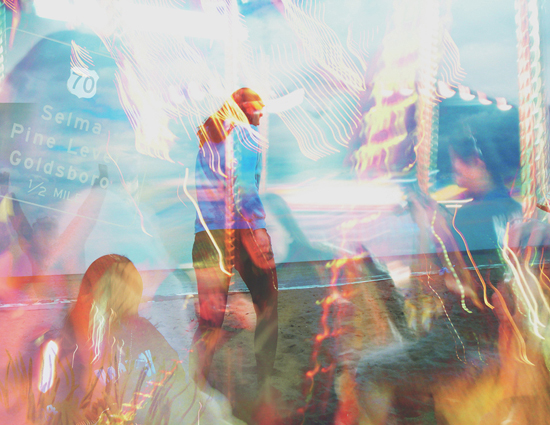
Contents
Acknowledgments
Thanks first and foremost to my wife, Laura Sherrill Ligon. She took photos and posed for photos used in the technical instructions in this book. Her painting Fried Eggs is used in the perspective exercises in are based on a pencil sketch by Laura. She is a constant sounding board and source of encouragement for my work in general and for this book in specific. Thanks also to my sons, Sam and Max, for patiently posing for crazy reference pictures and generally humoring their dad in his projects. Its a pleasure to watch them grow into smart, creative people.
Thanks to Rhonda Coble, who took the photos of the Egyptian statue used as the examples in the instructions for exercises 1 and 3 in .
Thanks to Linda Abrahamsen, Jeff Bodovetz, Chad Cummings, Julie Cummings, Kevin Czapiewski, Richard Fiorelli, Kevin Kautenburg, Jacqueline Kennedy, William Leddy, John Spofford, and Vikas Srivastava for posing for the photos used in the composite exercise in .
Thanks to Neal Reed and Kathy Anderson for patiently posing for the digital painting in exercise 1 in .
Thanks to my sister, Pam Mayor, for allowing her old photo to be the basis for exercise 1 in is based on a video still from Figure/Ground, my perennial work in progress. Thanks to Ian Hinkle, my director of photography for the film, for capturing the image, and thanks to actresses Lindsey and Lauren Hyde, who appear in the video image.
Thanks to author/director Michael W. Dean for inspiration and specific help. In addition to the foreword for this book, Michael recommended the book proposal to his agent, which resulted in a great and propitious experience. Additional thanks to Michael and his wife, Debra Jean Dean, for proofreading the original book proposal and making helpful suggestions. Thanks also to Webb and Ricki Sherrill for proofreading, as well as for general help and encouragement!
Thanks very much to Margot Hutchison of Waterside Productions, my book agent for this project. She has been a pleasure to work with, labored mightily on behalf of this first-time author, and did an all-around great job. Thanks to publishers Watson-Guptill/Random House for the wonderful opportunity. Thanks to editors Joy Aquilino and John Foster for patience and informed guidance regarding this project.
Thanks to Adobe for making such great creative tools. I use them on a daily basis. Thanks to Wacom, Canon, and Kodak for providing images for this book. Thanks to Elizabeth Saluk at the Cleveland Museum of Art for help in obtaining permission to use images from art history. Thanks to Michael Pilmer for helping us to obtain permission to use images created by Mark Mothersbaugh and thanks to Mark!
Thanks to all the artists who allowed their work to be included in the book. These visual examples are a big help in clarifying the instruction.
Thanks very much to my students in general, and more specifically those students whose works are included as practical examples of project solutions.
Thanks to the Cleveland Institute of Art and my colleagues there. It is a privilege to teach at such a great school and be surrounded by such smart, creative individuals on a daily basis. Thanks to the University of Mary Washington, where I was both student and instructor (with several years in between the two!). Thanks to Joseph DiBella, Richard Dawson, Dave Tanks, Petra Soesemann, and Kevin Kautenburger for providing teaching opportunities and for general guidance, friendship, and help. Thanks to Grace Hartigan for being a powerful and significant mentor, influence, and inspiration.
Thanks to Attorney Joni Davis and Attorney Andre Des Rochers for legal help and advice regarding this book.
Foreword
BY MICHAEL W. DEAN
I first heard of Scott Ligon in 2006, when he wrote me a snail-mail letter and sent me a DVD of his animated short film Escape Velocity. The letter said that my book, $30 Film School, had influenced him to make films. My book had sold many thousands of copies, and was more than a simple tech book: it was, for many, a bible, a way of life. I was amazed that this little message in a bottle that Id written on my old laptop in a crappy, little studio apartment had touched so many people around the world. And it seemed like all of them sent me a DVD of the film theyd made as a result. When these DVDs started filling my PO box, I would eagerly watch all of them.
But I soon realized that the same truism I had discovered twenty years earlier when putting out vinyl of my own punk rock musicafter listening to all the other punk rock vinyl put out by everyone else in the early 80swas also true of digital filmmaking: when everyone can make a record (or in this case a movie), everyone does, and most of them suck.
The pithy little statement Id come up with to describe this phenomenon was: Ill fight to the death for your right to make your movie, but I dont want to have to watch it. This may sound callous, but the simple logistics of trying to have a life and moving on to my next long art project made it impossible to watch all of the films that were sent to me as a result of writing my book. I gave everyone an A for effort in my mind, but most of the films were not ones that Id go out of my way to watch.
When $30 Film School went into a second edition, I was asked by the publisher to produce a DVD to accompany it, rather than the CD the first edition had. I pulled Scotts film out of the Ill-watch-these-someday pile by my desk. I remembered that Id really liked his cover letter. It seemed very genuine, without kissing butt. And I was impressed that even though he said that his film was about his Attention-Deficit Disorder, there were no typos in his letter. Having a bit of ADD myself and knowing how hard it is to do proper written communication (even though I do it for a living), it impressed me. I popped his DVD into my laptop.


